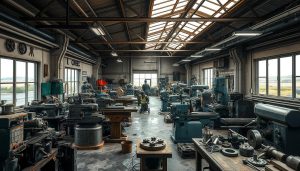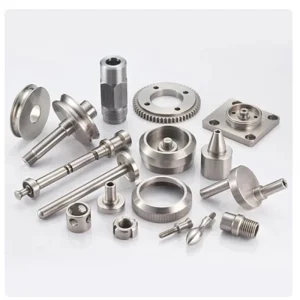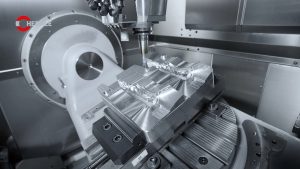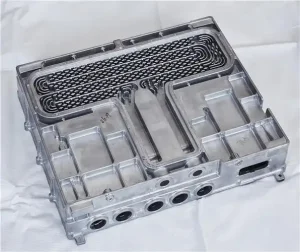Gears are key in many mechanical systems. Knowing their characteristics is vital for making efficient gear systems. Studying gear types and characteristics is a basic part of mechanical engineering.
This knowledge helps in creating new technologies. A good gear introduction is the first step to understanding gears and their uses.
There are different gear types, like spur, helical, and bevel gears. Each has its own strengths and is best for certain tasks. Knowing what each gear can do is important for picking the right one for a job.
This choice helps engineers make gear systems that work well and meet standards. It’s all about finding the perfect gear for the task at hand.
In mechanical engineering, learning about gear characteristics is very important. Knowing about the different gear types and their features is key to making efficient systems. By grasping the basics of gear characteristics, engineers can come up with creative solutions.
These solutions meet the changing needs of industries like cars and machinery. It’s all about using knowledge to innovate and improve.
What Are the Characteristics of Gears?
Gears are key parts in many mechanical systems. Their performance depends on the materials, how they’re made, and their design. For example, strong materials make gears last longer, and precise manufacturing improves their accuracy.
The shape, size, and tooth details of gears are very important. Features like the pitch circle diameter and tooth width affect how well gears work. Knowing these details helps in designing gears that work well with other parts.
Basic Gear Terminology
Understanding basic gear terms is important. Words like pitch, modules, and pressure angle help describe gear shapes. Also, knowing about gear materials is key to picking the right ones for different jobs.
Fundamental Gear Properties
Gears have special properties that make them useful. They can change the speed and torque of a machine. The material of the gear affects its strength and how long it lasts.
Key Geometric Features
The shape and size of gear teeth are very important. Good design ensures gears work well and last long. By focusing on materials, manufacturing, and design, engineers can make gears that perform well in many situations.
Physical Properties and Material Composition
The strength and durability of gears are key to their performance and life span. The material they’re made of greatly affects these properties. For example, steel gears are strong and durable, making them ideal for high-stress situations. On the other hand, aluminum gears are lighter and used where weight is a concern.
Gears can be made from metals, plastics, or composites. Each material has its own strengths, like density, hardness, and corrosion resistance. The right material choice depends on the gear’s application and needed properties.
Some common materials for gears include:
- Steel: known for its high strength and durability
- Aluminum: preferred for its lightweight and corrosion-resistant properties
- Plastics: often used in low-stress applications due to their low cost and ease of production
The design and manufacturing process also impact gear properties. For instance, heat treatment can make steel gears stronger. Surface coatings can also enhance aluminum gears’ resistance to corrosion.
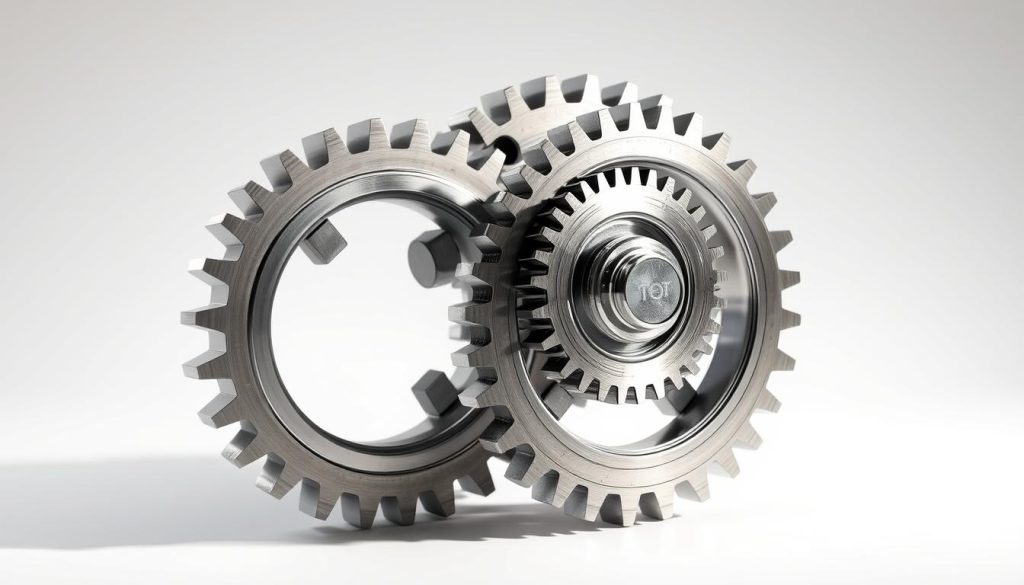
Knowing about gear properties and materials is vital for creating efficient gear systems. By choosing the right material and design, engineers can improve gear performance and life span. This reduces failure risks and boosts system efficiency.
| Material | Gear Strength | Durability | Corrosion Resistance |
|---|---|---|---|
| Steel | High | High | Medium |
| Aluminum | Medium | Medium | High |
| Plastics | Low | Low | Low |
Types of Gear Systems and Their Functions
Gear systems are key in many machines, helping to move power and motion. They vary based on their use, like in cars, planes, and factories. Knowing about different gear systems helps pick the right one for each job.
There are main types like spur, helical, bevel, and worm gears. Each has its own strengths and weaknesses. For example, spur gears work well at low speeds because they’re simple and reliable. Helical gears handle high speeds and heavy loads better, making them quieter.
Spur Gears
Spur gears are the most common. They have straight teeth and are used in many places. This is because they’re easy to use, reliable, and simple to fix.
Helical Gears
Helical gears have angled teeth and are for high-speed, heavy-duty jobs. They’re found in gearboxes and transmissions, giving smooth and quiet operation.
Bevel and worm gears also have their uses. Bevel gears work between perpendicular axes, and worm gears offer high gear ratios. Choosing the right gear system depends on the job’s needs, like load, speed, and conditions.
| Type of Gear System | Characteristics | Applications |
|---|---|---|
| Spur Gears | Straight teeth, parallel axes | Low-speed applications, automotive, industrial machinery |
| Helical Gears | Angled teeth, high speeds, heavy loads | High-performance applications, gearboxes, transmissions |
| Bevel Gears | Perpendicular axes, high gear ratios | Power transmission, industrial machinery |
| Worm Gears | High gear ratios, low speeds | Gearboxes, transmissions, industrial machinery |
In summary, knowing about gear systems is key for the right choice. It’s about matching the gear to the job, considering things like application, function, and performance.
Critical Design Parameters in Gear Engineering
In gear engineering, design parameters are key to a gear system’s performance and efficiency. The choice of materials, gear teeth design, and gear optimization are vital. Engineers must think carefully about these factors and how they work together.
Some important things to consider in gear engineering are:
- Material selection: The right materials can reduce friction, wear, and vibration.
- Teeth design: The shape, size, and spacing of teeth affect efficiency.
- Gear optimization: Advanced CAD software can improve gear design and performance.
By focusing on these design parameters and using new technologies, engineers can make gear systems better. This leads to better performance, less maintenance, and more productivity.
The main aim of gear engineering is to create gear systems that fit specific needs, save costs, and boost efficiency. By paying attention to design parameters and using advanced tools, engineers can achieve this. They can make gear systems that help industries succeed.
| Design Parameter | Description |
|---|---|
| Material Selection | Choosing the right materials for gear construction |
| Teeth Design | Designing gear teeth for optimal performance |
| Gear Optimization | Using CAD software to optimize gear design |
Manufacturing Methods and Quality Standards
In the gear production world, many methods and standards are used to make gears reliable and perform well. The method chosen depends on the gear type, material, and needed precision. Old methods like hobbing and shaping are common, but new ones like CNC machining are more precise and efficient.
Quality standards are key in gear making. They make sure gears are up to par and work as expected. Quality checks and tests help find and fix problems early. This way, gear makers can create top-notch gears for many industries, from cars to planes.
Several things affect the choice of how to make gears and the quality standards. These include:
- Material selection: The material used affects the making method and quality.
- Design complexity: How complex the gear design is also matters.
- Production volume: How many gears are made impacts the choice of method and standard.
Knowing about different gear making methods and standards helps manufacturers. They can improve their processes to make high-quality gears. This makes gear systems more reliable and efficient.
Applications Across Different Industries
Gears are used in many fields like automotive, industrial machinery, and precision instruments. They help in efficiently moving power and motion. In cars, gears are key in transmissions and gearboxes for smooth power flow.
In factories, construction, and farms, gears power machinery. High-quality gears are vital for machines to work well. Watches and medical tools also need precise gears for accurate work.
Key Industries and Their Requirements
- Automotive: high-torque and high-speed gears for transmissions and gearboxes
- Industrial Machinery: durable and reliable gears for heavy-duty applications
- Precision Instruments: high-precision gears for accurate and reliable performance
Gears in these fields need special designs and materials. New gear tech and materials make systems better and more reliable. This has led to big improvements in many areas.

In summary, gears are essential in many industries for better systems. They are key in cars, factories, and precise tools. New gear tech will keep improving these areas.
| Industry | Application | Requirement |
|---|---|---|
| Automotive | Transmissions | High-torque and high-speed gears |
| Industrial Machinery | Manufacturing | Durable and reliable gears |
| Precision Instruments | Watches and medical equipment | High-precision gears |
Conclusion: The Future of Gear Technology
The need for better and more reliable gears is growing fast. This is changing the gear technology world with new materials and ways to make things. New materials and 3D printing are making gears lighter and stronger.
The gear industry is seeing a lot of new ideas. Engineers are working hard to make gears better. This will help many areas, like cars and machines, work better and use less energy.
As we look ahead, gear makers will keep finding new ways to improve. They will use smart tools and data to make gears that can change and adapt. This will help meet the needs of today’s world.
